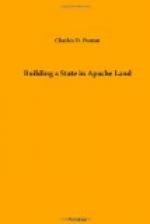The Pima handiwork in earthenware, horsehair, bridle reins, ropes, and domestic utensils, is remarkably ingenious. They formerly cultivated cotton and manufactured cotton cloth of a very strong quality. The men understood spinning and weaving, and passed the winter in this industrial pursuit.
Their subsistence is wheat, corn, melons, pumpkins, vegetables, and the wild fruits. They have herds of cattle, plenty of horses, and great quantities of poultry.
The Americans are indebted to the Pima Indians for provisions furnished the California emigration, and for supplies for the early overland stages, besides their faithful and unwavering friendship.
The habitations of these prehistoric people form the most unique of all the anomalous dwellings of Arizona, and a more minute investigation than has hitherto been made will show the earliest habitations of man. There are similar edifices in Egypt and India, but they are mostly temples. These Arizona cliff dwellings are the only edifices of the kind that are known to have been inhabited by mankind. They exist mostly in the mountains in the northern portion of Arizona. A more ancient race, still, lived in the excavations on the sides of the mountains, prepared, no doubt, as a refuge against enemies.
At the time of our first exploration (1854) there was virtually no civilized population in the recently acquired territory. The old pueblo of Tucson contained probably three hundred Mexicans, Indians, and half breeds. The Pima Indians on the Gila River numbered from seven to ten thousand, and were the only producing population. We could not explore the country north of the Gila River, because of the Apaches, who then numbered fully twenty thousand. For three hundred years they have killed Spaniards, Mexicans, and Americans, which makes about the longest continuous war on record.
It was impossible to remain with a considerable number of men in a country destitute of sustenance; so we followed the Gila River down to its junction with the Colorado, and camped on the bank opposite Fort Yuma, glad to be again in sight of the American flag. The commanding officer, Major—afterwards General—Heintzelman, issued the regulation allowance of emigrant rations, which were very grateful to men who had been living for some time without what are usually called the necessaries of life. Fort Yuma was established in 1851, to suppress the Indians on the Colorado, and to protect emigrants at the crossing.
It was apparent that the junction of the Gila and Colorado must be the seaport of the new territory.
The Colorado was supposed to be navigable nearly seven hundred miles, and steamboats were already at Yuma transporting supplies for the post. By the treaty with Mexico of 1848 the boundary line was established from the mouth of the Rio Grande northwardly to the headwaters of the Gila River, thence along the channel of the Gila River to its confluence with the Colorado. The treaty then says: “From a point at the confluence of the Gila and Colorado rivers, westerly to a point on the Pacific Ocean six miles south of the southernmost point of the Bay of San Diego.”




